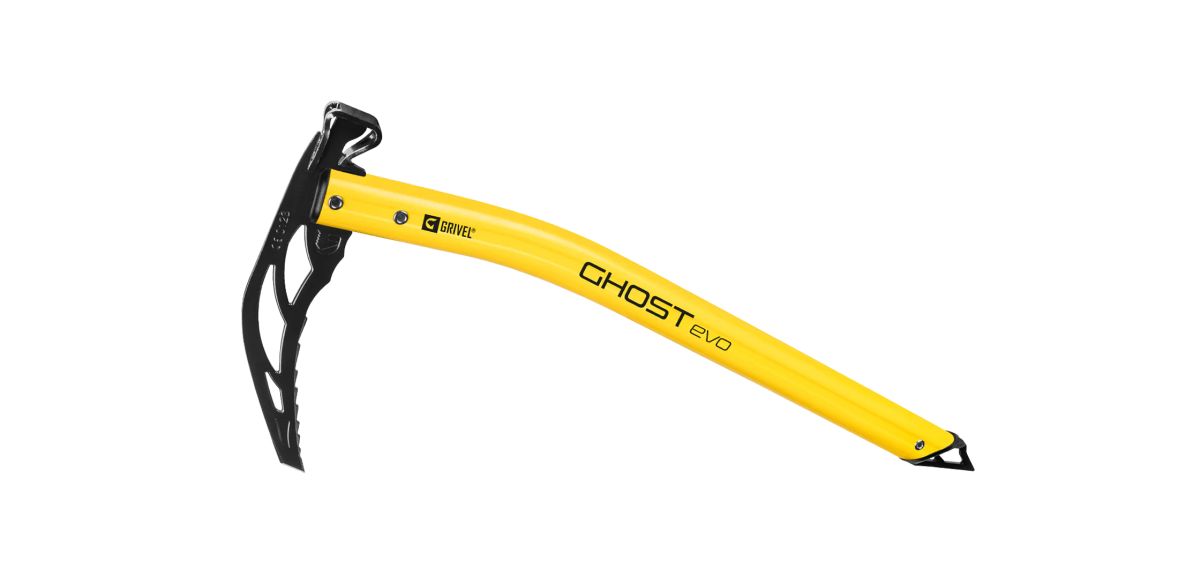
Grivel Ghost Evo Ice Axe
15/11/2024
By Tom Hoyle
Grivel's entry in the lightweight ice axe category inevitably draws comparison to the Petzl Gully. Petzl's 280g axe is a very popular choice amongst ski mountaineers and anyone else who travels fast and light in the mountains. Available as both an adze and hammer, the Ghost Evo is slightly heavier at 309g—but in reality both axes are incredibly light for how well they perform and it is the other design choices which should guide your decision between the two.
The ~30g weight difference isn't hugely significant, especially given the Grivel axe sports two rivets securing the pick to the shaft—while the Petzl only has one—suggesting that Grivel have produced a stronger axe and accepted a slight weight penalty. The Petzl axe has an adjustable trigger rest and recurved pick with a narrow profile, suggesting that for climbing steep ice it is the better of the two, due to the more secure and less-fatiguing grip feature. Of course, climbing steep ice is really the realm of much more specific—and much heavier—tools. At a pinch, both axes will climb steep ice, but if doing so for an extended pitch then you are going to be wishing for a different tool whether you are swinging the Gully or the Ghost.
For the majority of travel, plunging the shaft of a lightweight axe or using it with dagger technique is more likely, assuming you have chosen the right tool for the conditions you are out in. In these use cases, I think the Ghost is the better choice—it sports a dedicated shaft spike and is a great tool for plunging the shaft. The taller pick profile is arguably a better shape and size for holding the head of the axe as well. The Gully doesn't have a dedicated spike, instead the hollow aluminium shaft is cut at an angle to create a rounded U-shaped point (which also is home to a hole for leash attachment, as has the spike on the Ghost). This aids penetration when plunging the shaft in snow, but there is also a plastic stopper to stop snow filling the shaft and overall it is much less effective than the Ghost's proper spike. If the Gully's trigger rest is anywhere near the lower part of the shaft of the axe, this also inhibits plunging, so this feature has a real trade-off of security when swinging the axe meaningfully versus plunging the shaft. For my money, the dedicated spike on the Ghost is the better design choice.
When daggering, the curve of the pick, the pick profile and G-bone shaft shape of the Ghost are secure and comfortable and it feels like a better tool to me than the Gully, but the case here is less clear cut and may come down to personal preference. I also think the balance of the Ghost is slightly better and the additional weight near the head of the axe is going to help with penetration when swinging into hard ice, though as already mentioned, the Gully's trigger rest is going to give you a more secure and less-fatiguing grip.
There's not much else to discuss here, both axes are surprisingly capable and not the toys that their weights suggest. The hammer on the Ghost does its job—I was able to pound a snowstake into an icy ridgeline for a bit of security without any problem. It might have gone in with a few less trikes from a heavier axe, but that's hardly significant. The head of the snowstake predictably showed considerably more sign of abuse than the hammer on the Ghost.
For hard ice, sustained steep travel, or mixed ground you are going to want a heavier, more specific ice tool. But for the kind of travel in ski-mountaineering where you are generally seeking out the most straightforward way to the top of skiable snow, this kind of tool does an admirable job—without adding crippling weight to your backpack. If travelling above the snowline on an alpine traverse or a mellow snow climb, where you aren't sure if you'll need an axe, these axes are light enough that I'd just carry one without a second thought. The trade-off in weight for the security they give when you realise you do need them is worth every gram.
